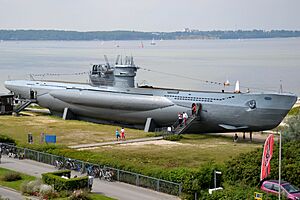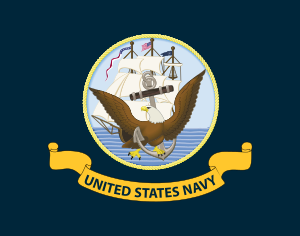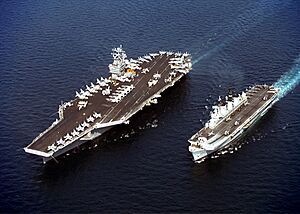Navy facts for kids
A navy is a part of a country's armed forces. Its main job is to protect a nation's interests on the water. This includes lakes, rivers, coastal areas, and the wide ocean. Navies use many types of vessels. These include surface ships, submarines, and aircraft that fly from ships. They also handle support, communication, and training.
Navies have two main goals. One is to protect a country's shores and important sea routes. They also help stop piracy and move troops. Another goal is to prevent enemies from using the sea against their country. Some navies also use special submarines. These submarines carry powerful missiles for defense. This helps keep peace by discouraging attacks. Navies operate in different areas. Some stay close to shore (called "brown-water" or "green-water" navies). Others travel across vast oceans (known as "blue-water" navies).
Contents
The word "navy" comes from old words meaning "ship" or "fleet." It appeared in English around the 1300s. The word "naval" also comes from Latin, meaning "about ships."
Long ago, the word "navy" could mean any group of ships, for trade or for fighting. Today, when we say "navy," we usually mean a country's military ships. However, you might still hear "merchant navy" for ships that carry goods for trade. In the past, it was common for private ships to be used for fighting. They could add artillery and soldiers to become warships. This was especially true before modern military technology.
Naval warfare began when people first fought from boats. Early battles involved ramming enemy ships. Soldiers would also board enemy vessels for hand-to-hand combat. This was common in ancient Greece and the Roman Empire. They used long, narrow ships powered by many oarsmen.
Ancient China had large naval battles. They used war junks during the Han dynasty. China's first official navy started in the 12th century. This was during the Southern Song dynasty. The Chola Dynasty in Southern India also had a strong navy. They used trade ships to carry armies overseas.
People in the Nusantara region (Southeast Asia) were also great seafarers. They built large ships called jong. These ships could carry hundreds of men. They sailed vast distances for trade and expeditions.
The Age of Sail
The invention of the cannon changed naval warfare. Ships became larger to carry more cannons. They started using sails instead of oars for power. Warships were designed to fire all their cannons from one side. This was called a "broadside." Ships would line up to create a "line of battle."
European navies grew quickly during this time. The Spanish and Portuguese navies were very powerful. They helped explore the world and establish colonies. The Royal Navy of England became a major force. It gained supremacy over other navies by the 19th century. A key victory was the Battle of Trafalgar in 1805.
Steam, Armor, and Submarines
The next big change was metal plating on ship hulls. This made wooden ships outdated. These heavy, armored ships needed steam-powered engines. The French Gloire and British HMS Warrior were among the first. Rotating turrets were also invented. These allowed guns to aim in any direction. The battle between CSS Virginia and USS Monitor in the American Civil War showed this new era.

Submarines were developed in the late 1800s. They proved very effective in World War I. During World War II, German submarines, called U-boats, caused great damage. They attacked shipping lanes in the Atlantic Ocean.
The Rise of Aircraft Carriers
A huge shift happened with the aircraft carrier. These ships could launch planes far from shore. These planes could attack enemy ships and land targets. The Battle of Taranto (1940) and Pearl Harbor (1941) showed their power. By the end of World War II, carriers became the most important warships.
After World War II, the United States Navy became the largest in the world. It has maintained a huge fleet ever since. During the Cold War, the Soviet Navy also grew very strong. Today, only a few countries operate large aircraft carriers. These include the United States, France, Russia, China, India, and the United Kingdom.
Navies usually work from naval bases. These are special ports for naval operations. They have docks, repair facilities, and supply depots. During wartime, temporary bases might be built closer to important areas.
Navy ships can work alone or in groups. A small group is a squadron. A larger group is a naval fleet. The leader of a fleet travels in the flagship. This is usually the most powerful ship. In the past, commands were sent using flags. Today, radios are used.
A "blue-water navy" operates far from its home country's coast. These ships can stay at sea for long periods. They need a lot of support from other ships. Many are also nuclear-powered. A "brown-water navy" operates close to shore. They work in coastal areas and rivers. A "green-water navy" operates in between these two. It can project power in its region.
Navies have many interesting traditions. One basic rule is that most large military vessels are called "ships." Smaller ones, like submarines, are often called "boats." The name of a ship usually has a prefix. This shows which country's navy it belongs to (like HMS for British ships or USS for American ships).
The ship's bell is an important tradition. It was used to tell time and for alarms. The captain and senior officers are "piped" aboard. This is a special welcome using a Boatswain's call. In the United States, the First Navy Jack flag has the words "Don't Tread on Me."
Historically, ships were often called "she." It was once believed that women on naval vessels would bring bad luck. However, this is no longer the case. Today, women serve in all roles in navies around the world. Firing a cannon salute shows respect and trust. The number of cannons fired shows the rank of the person being honored.
Historically, navy ships were built only for fighting. They carried weapons and supplies. Today, navy ships are more specialized. They include combat ships, supply ships, and repair ships.
Modern navy combat ships fall into seven main types:
- Aircraft carriers: Carry aircraft for attack and defense.
- Cruisers: Large, powerful warships for various missions.
- Destroyers: Fast, agile ships for defense and attack.
- Frigates: Smaller than destroyers, used for escort and patrol.
- Corvettes: Even smaller warships, often for coastal defense.
- Submarines: Operate underwater for stealth and attack.
- Amphibious assault ships: Carry troops and equipment for landings.
There are also support ships. These include oilers, minesweepers, and patrol boats. Modern warships are much faster and more efficient. They can travel long distances without refueling. Today, naval groups on long missions are always followed by support ships. These ships provide fuel, food, and medical care. This allows combat ships to stay at sea for months.
The term "boat" refers to smaller craft. They are limited in size and usually cannot make long voyages alone. A common saying is that boats can be carried by ships. Submarines are often called boats, even though they are large.
Navies use many types of boats. These range from small dinghies to large landing craft. They are powered by diesel engines or waterjets. Patrol boats guard coastal areas and rivers. Landing craft carry troops and vehicles from ship to shore. Special operations craft are fast boats for special forces. Other boats are used for rescue, diving, and survey work.
Naval forces are organized into units. A single ship is the smallest unit. Ships can be grouped into squadrons or flotillas. These can then form larger fleets. A task force is a temporary group of ships. It is put together for a specific mission.
Navies have many different roles for their personnel. These include sailors, engineers, pilots, and many others. Today, women serve in all areas of naval service. This includes serving on submarines. Countries like Australia, Canada, Norway, Spain, the United Kingdom, and the United States allow women in submarine service.
Navies have different ranks for their personnel. There are ranks for enlisted personnel and for officers. Officers typically have ranks like:
- Midshipman / Ensign
- Sub Lieutenant / Lieutenant Junior Grade
- Lieutenant
- Lieutenant Commander
- Commander
- Captain
- Commodore / Rear Admiral (lower half)
- Rear Admiral / Rear Admiral (upper half)
- Vice Admiral
- Admiral
- Admiral of the Fleet / Fleet Admiral
"Flag officers" are those with the rank of admiral or commodore. They usually command large groups of ships. The highest rank depends on the size of the navy. It also depends on whether it is wartime or peacetime.
Naval infantry, often called marines, are soldiers who are part of a navy. They perform roles both on land and at sea. Their jobs include amphibious operations. This means landing from ships onto enemy shores. They also perform other land warfare tasks.
In the past, marines were soldiers on ships. They would fight during boarding actions. They also conducted raids along coastlines. The Spanish Infantería de Marina was formed in 1537. It is the oldest marine force still active today. The British Royal Marines are known for their commando training. The United States Marine Corps is a separate branch of the US armed forces. It works closely with the US Navy.
Naval aviation is the use of military aircraft by navies. These aircraft can fly from warships, especially aircraft carriers. They can also operate from land bases.
In World War I, navies used floatplanes for scouting. By World War II, aircraft carriers carried bombers and fighters. These planes could attack ships and land targets. Since World War II, helicopters have been used on smaller ships. They help with anti-submarine warfare and transport. Naval aircraft perform many important roles for a country's defense.
Related pages
Images for kids
-
The Spanish Armada fighting the English navy at the Battle of Gravelines in 1588.
-
British and Danish navies in the line of battle at the Battle of Copenhagen (1801).
-
A group of ships from the Indian Navy's Western Fleet with aircraft carriers INS Viraat and INS Vikramaditya in the Arabian Sea in 2014.
-
An ancient Roman painting showing a naumachia (mock naval battle) with triremes, from the Temple of Isis in Pompeii.
-
HMS Invincible sailing towards the Falkland Islands during the Falklands War of 1982. This war was the largest naval conflict since World War II.
-
US Navy officers on the aircraft carrier USS Abraham Lincoln checking defense systems during maritime security operations. Navies sometimes do operations that are not direct warfare.
-
INS Shivalik is a stealth frigate of the Indian Navy, designed to be hard to detect.
-
The Royal Canadian Navy's Orca-class patrol vessel.
-
Newly appointed officers celebrating their new roles by throwing their hats in the air at a U.S. Naval Academy graduation.
-
From left to right: President P. E. Svinhufvud and Commander Einar Schwank of the Finnish Navy at the Crichton-Vulcan shipyard in Turku, Finland, in 1931.
-
Jaubert commandos of the French Navy showing a practice sea assault on the support vessel Alcyon.
See also
 In Spanish: Armada para niños
In Spanish: Armada para niños
- Blue-water navy
- Coast guard
- List of naval battles
- List of navies
- Naval academy
- Naval fleet
- Naval tactics
- Naval warfare























